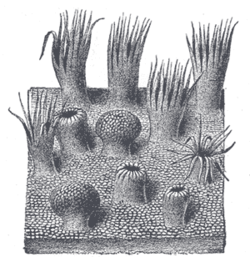| Lingual papillae | |
|---|---|
 Anatomic landmarks of the tongue. Filiform papillae cover most of the dorsal surface of the anterior 2/3 of the tongue, with fungiform interspaced. Just in front of the sulcus terminalis lies a V-shaped line of circumvallate papillae, and on the posterior aspects of the lateral margins of the tongue lie the foliate papillae. | |
 Semidiagrammatic view of a portion of the mucous membrane of the tongue. Two fungiform papillae are shown. On some of the filiform papillae the epithelial prolongations stand erect, in one they are spread out, and in three they are folded in. | |
| Details | |
| Part of | Tongue |
| Identifiers | |
| Latin | papillae linguales |
| NeuroLex ID | birnlex_4102 |
| TA98 | A05.1.04.013 |
| TA2 | 2837 |
| TH | H3.04.01.0.03006 |
| FMA | 54819 |
| Anatomical terminology | |
Lingual papillae (sg.: papilla) are small structures on the upper surface of the tongue that give it its characteristic rough texture. The four types of papillae on the human tongue have different structures and are accordingly classified as circumvallate (or vallate), fungiform, filiform, and foliate. All except the filiform papillae are associated with taste buds.[1]
- ^ Norton N (2007). Netter's head and neck anatomy for dentistry. illustrations by Netter FH. Philadelphia, Pa.: Saunders Elsevier. p. 402. ISBN 978-1929007882.